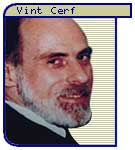 |
|||
 |
|||
![]() Surfing the
Net
Surfing the
Net
 Norm Abramson, a professor of
engineering at Stanford, had a personal
interest in Hawaii. It was surfing. He was an avid surfer and after
a visit to Hawaii in 1970, he inquired at the University of Hawaii
if they were interested in hiring a professor of engineering. Within
a year he was working at the University and surfing on the beaches
in Hawaii.
Norm Abramson, a professor of
engineering at Stanford, had a personal
interest in Hawaii. It was surfing. He was an avid surfer and after
a visit to Hawaii in 1970, he inquired at the University of Hawaii
if they were interested in hiring a professor of engineering. Within
a year he was working at the University and surfing on the beaches
in Hawaii.
Abramson immediately started working on a radio-based data communications system to connect the Hawaiian islands together, and he got Larry Roberts to fund the project. Abramson's team of engineers and graduate students eventually built the first wireless packet-switched network, and in true Hawaiian style, they named it ALOHAnet.
Abramson then managed to get a Terminal IMP from Larry Roberts in early 1971 and connected the ALOHAnet to the ARPAnet on the mainland. It was the first time another big network was connected to the ARPAnet.
TCP/IP
At about the same time, the weaknesses of the Network Control Protocol (NCP)
were becoming more apparent. In 1970,
Bob Kahn and
Vint Cerf ran an
experiment from UCLA to see if they could overload the network under high
but acceptable network traffic. Kahn had warned the engineers at BBN when
they were building the IMPs, but
Frank Heart thought the NCP was more
than adequate for the amount of traffic they expected. However, the ARPAnet was
getting more traffic than predicted.
 While waiting for a meeting one day,
Vint Cerf started daydreaming
about a new protocol that would improve the efficiency of the network
and allow different networks to connect together into one big network
- an Internet. He jotted down some notes and then met with Bob Kahn
to work out the details. Together they came up with a protocol that
would include error detection, packaging, and routing. They called
it Transmission Control Protocol, but later split off part of it and
called that part Internet Protocol. Together the acronym became TCP/IP.
While waiting for a meeting one day,
Vint Cerf started daydreaming
about a new protocol that would improve the efficiency of the network
and allow different networks to connect together into one big network
- an Internet. He jotted down some notes and then met with Bob Kahn
to work out the details. Together they came up with a protocol that
would include error detection, packaging, and routing. They called
it Transmission Control Protocol, but later split off part of it and
called that part Internet Protocol. Together the acronym became TCP/IP.
TCP/IP was a necessary step in the evolution of the Internet. The earlier protocol, NCP, couldn't handle the tremendous traffic of a global network, and TCP/IP was a common protocol different networks could use to talk to each other. However, it took several years before TCP/IP became the default protocol for the Internet. The International Standards Organization (headquarted in Europe) proposed a competing protocol named OSI (Open Systems Interconnection). It was a more abstract protocol created by some of the world's best computer scientists. However, TCP/IP was a protocol that was already proven and it was gaining momentum.
The United State's government proclaimed OSI was the protocol the Internet was going to use, but it never happened. Too many networks were already using TCP/IP and it was too much trouble to switch. Europe mandated using OSI, but the universities were switching over to TCP/IP anyway because they didn't want to cut themselves off from the giant Internet in the United States.
With TCP/IP, the "global network" was becoming a reality. Universities and government offices were using the network for communicating with colleagues and exchanging data. However, sometimes a less professional application snuck into the Internet. Personal email became more common, and some hackers wrote network games and other recreations. The intent of the Internet was strictly for official business, and it was even a law -- but people started rethinking the purpose of the Internet.
Copyright © 1998, PBS Online,
Inc. All Rights Reserved.
Site Designed and Developed by OPB Learning
Media